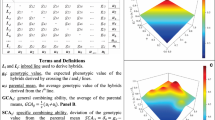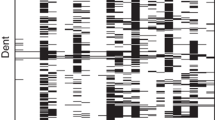Abstract
Predicting single-cross performance is of special interest in hybrid breeding of triticale. We used molecular and phenotypic data of factorial triticale crosses and compared several approaches to predict their single-cross performance. Twenty-three inbred lines and their 76 incomplete factorial crosses were field evaluated for grain yield, plant height, and heading time at five locations in Central Europe. In addition, the parental lines were genotyped with 52 SSR markers. Plant height and heading time were predicted with high accuracy based on mid-parent performance. In contrast, prediction of hybrid performance based on mid-parent value was not accurate for grain yield. Using general combining ability effects led to an enhanced prediction accuracy of hybrid grain yield performance. This accuracy could be slightly improved using best linear unbiased prediction approaches. The prediction accuracy was considerably high even if the number of tested hybrids was small. Consequently, best linear unbiased prediction of hybrid performance is a promising tool for hybrid triticale breeding programs.



Similar content being viewed by others
References
Barker TC, Varughese G (1992) Combining ability and heterosis among eight complete spring hexaploid triticale lines. Crop Sci 32:340–344
Bernardo R (1994) Prediction of maize single-cross performance using RFLPs and information from related hybrids. Crop Sci 34:20–25
Bernardo R (1996) Best linear unbiased prediction of maize single-cross performance. Crop Sci 36:50–56
Bernardo R (2002) Breeding for quantitative traits in plants. Stemma Press, Woodbury
Charcosset A, Bonnisseau B, Touchebeuf O, Burstin J, Dubreuil P, Barriere Y, Gallais A, Denis JB (1998) Prediction of maize hybrid silage performance using marker data, comparison of several models for specific combining ability. Crop Sci 38:38–44
Dekkers JCM (2007) Prediction of response to marker-assisted and genomic selection using selection index theory. J Anim Breed Genet 124:331–341
Doyle JJ, Doyle JL (1990) Isolation of plant DNA from fresh tissue. Focus 12:13–15
Fischer S, Möhring J, Maurer HP, Piepho HP, Thiemt EM, Schön CC, Melchinger AE, Reif JC (2009) Impact of genetic divergence on the ratio of variance due to specific versus general combining ability in winter triticale. Crop Sci 49:2119–2122
Fischer S, Maurer HP, Würschum T, Möhring J, Piepho HP, Schön CC, Thiemt EM, Dhillon BS, Melchinger AE, Reif JC (2010) Development of heterotic groups in triticale. Crop Sci 50:584–590
Garcia AA, Wang S, Melchinger AE, Zeng ZB (2008) Quantitative trait loci mapping and the genetic basis of heterosis in maize and rice. Genetics 180:1707–1724
Gilmour AR, Gogel BG, Cullis BR, Thompson R (2009) ASReml User Guide Release 3.0. VSN International Ltd, Hertfordshire. http://www.vsni.co.uk
Gower JC (1966) Some distance properties of latent root and vector methods used in multivariate analysis. Biometrika 53:325–328
Hack H, Bleiholder H, Buhr L, Meier U, Schnock-Fricke U, Weber E, Witzenberger A (1992) Einheitliche Codierung der phänologischen Entwicklungsstadien mono- und dikotyler Pflanzen-Erweiterte BBCH-Skala, Allgemein Nachrichtenbl. Deutsch Pflanzenschutz 44:265–270
Hallauer AR, Miranda JBF (1988) Quantitative genetics in maize breeding. Iowa State University Press, Ames
Hallauer AR, Russell WA, Lamkey KR (1988) Corn breeding. In: Sprague GF, Dudley JW (eds) Corn and corn improvement, 3rd edn. Agron Monogr 18 ASA, CSSA, SSSA, Madison, p 463–564
Henderson CR (1985) Best linear unbiased prediction of non-additive genetic merits in non-inbred populations. J Anim Sci 60:111–117
Longin CFH, Mühleisen J, Maurer HP, Zhang H, Gowda M, Reif JC (2012) Hybrid breeding in autogamous cereals. Theor Appl Genet (In review)
Mantel N (1967) The detection of disease clustering and a generalized regression approach. Cancer Res 27:209–220
Maurer HP, Melchinger AE, Frisch M (2008) Population genetic simulation and data analysis with Plabsoft. Euphytica 161:133–139
Melchinger AE (1999) Genetic diversity and heterosis. In: Coors J, Pandey S (eds) The genetics and exploitation of heterosis in crops. ASA, CSSA, SSSA, Madison, pp 99–118
Oettler G, Burger H, Melchinger AE (2003) Heterosis and combining ability for grain yield and other agronomic traits in winter triticale. Plant Breed 122:318–321
Oettler G, Tams SH, Utz HF, Bauer E, Melchinger AE (2005) Prospect for hybrid breeding in winter triticale: I. Heterosis and combining ability for agronomic traits in European elite germplasm. Crop Sci 45:1476–1482
Panter DM, Allen FL (1995) Using best linear unbiased predictions to enhance breeding for yield in soybean. 2. Selection of superior crosses from a limited number of yield trials. Crop Sci 35:405–410
R development core team (2010) R: a language and environment for statistical computing, R foundation for statistical computing. http://www.R-project.org
Reif JC, Gumpert FM, Fischer S, Melchinger AE (2007) Impact of interpopulation divergence on additive and dominance variance in hybrid populations. Genetics 176:1931–1934
Reif JC, Kusterer B, Piepho H-P, Meyer RC, Altmann T, Schon CC, Melchinger AE (2009) Unraveling epistasis with triple testcross progenies of near-isogenic lines. Genetics 181:247–257
Reif JC, Zhao Y, Würschum T, Gowda M, Hahn V (2012) Prediction of sunflower single-cross performance. Plant Breed (accepted)
Rogers JS (1972) Measures of genetic similarity and genetic distance. Univ Texas Publ 7213:145–153
Stram DO, Lee JW (1994) Variance components testing in longitudinal mixed effects model. Biometrics 50:1171–1177
Tams SH, Bauer E, Oettler G, Melchinger AE (2004) Genetic diversity in European winter triticale determined with SSR markers and coancestry coefficient. Theor Appl Genet 108:1385–1391
Tams SH, Bauer E, Oettler G, Melchinger AE, Schön CC (2006) Prospects for hybrid breeding in winter triticale. II. Relationship between parental genetic distance and specific combining ability. Plant Breed 125:331–336
Wright S (1978) Evolution and genetics of populations, variability within and among natural populations, vol 4. The University of Chicago Press, Chicago, p 91
Xu W, Virmani SS (2000) Prediction of hybrid performance in rice: comparisons among best linear unbiased prediction (BLUP) procedure, midparent value, and molecular marker distance. Int Rice Res Notes 25:12–13
Zhao Y, Gowda M, Liu W, Würschum T, Maurer HP, Longin CFH, Ranc N, Reif JC (2012) Accuracy of genomic selection in European maize elite breeding populations. Theor Appl Genet 124:769–776
Acknowledgments
Y. Zhao and M. Gowda were supported by BMBF within the HYWHEAT Project (Grant ID: FKZ0315945D).
Author information
Authors and Affiliations
Corresponding author
Electronic supplementary material
Below is the link to the electronic supplementary material.
Rights and permissions
About this article
Cite this article
Gowda, M., Zhao, Y., Maurer, H.P. et al. Best linear unbiased prediction of triticale hybrid performance. Euphytica 191, 223–230 (2013). https://doi.org/10.1007/s10681-012-0784-z
Received:
Accepted:
Published:
Issue Date:
DOI: https://doi.org/10.1007/s10681-012-0784-z




